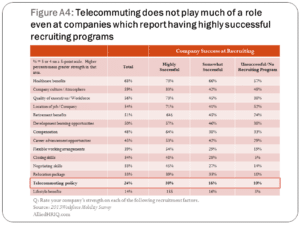Telecommuting Doesn’t Have a Major Impact With Employees
(Editor’s Note: Today’s post is brought to you by Allied Van Lines®, a leader in the moving and storage industry with more than 75 years of experience. For a second year, they are championing a research project, Allied HRIQ, aimed to provide business professionals with data on current workforce trends. I’m honored to be working with Allied again and hope you find the information interesting.)
A few months ago, Yahoo! President and CEO Marissa Mayer banned telecommuting. The response uproar backlash was swift. Experts from everywhere said telecommuting is essential to employee satisfaction and engagement. Some said this was the first sign of the apocalypse. All right – you caught me. No one really said that … but you would have thought the world was coming to an end given all the media attention.
Let me toss an idea out there. Maybe telecommuting isn’t the utopia we think it is. Or that it’s been hyped up to be.
By definition, telecommuting is when employees do not travel to a central place of work. Telecommuting is also referred to as telework or remote work. Typically when a person telecommutes, they’re working from home. So chances are, they have a home office. Although there are some telecommuters who work from airports and coffee shops.
This is different than flexible work (aka flextime). Flexible work is when employees have the ability to adjust their work hours. There might be some core hours that everyone is required to be in the office. That’s probably driven by operational needs. But there are hours that employees can “flex” to accommodate traffic, parenting responsibilities, caregiving duties, etc.
I must admit there have been times when I’ve used the terms telecommuting, telework, flexwork, etc. interchangeably. But the terms are very different and this year’s Allied HRIQ research shares some interesting findings where recruiting, telecommuting, and flexible work are concerned.
In looking at the chart above it will be no surprise that corporate culture, management and leadership, and professional development were high on the list. Healthcare was rated number one – which I find surprising. Companies feel they have more strength in their healthcare package than with the quality of senior leadership.
But the thing that caught my eye was telecommuting rated pretty low on the list. Given the reaction to the Mayer decision, I expected telecommuting to be higher. Interesting note: flexible working arrangements was several places above telecommuting.
Then it occurred to me. Telecommuting is about working from home. As someone who currently works from home, I’ll confess – it can be tough. Work is always staring you in the face. You have to learn how to deal with it. If employees aren’t able to figure out how to create balance when they live and work in the same place, it can be a detriment to productivity and employee morale.
On the other hand, it’s impossible to shut off our personal lives when we arrive at work. Employees do have outside commitments and obligations. Having flexible work arrangements give employees the ability to deal with all the other things in their lives and still get their work done in an office environment. And they don’t necessarily need a home office. So work doesn’t need to stare them in the face every evening.
I’m certainly not saying that companies with telecommuting programs should toss them out the window. Allied HRIQ’s research reminded me that telecommuting isn’t necessarily an employee engagement Shangri-La. Just because it works for one company or one individual doesn’t mean it will work for everyone. Some organizations may find other options, like flexible work, bring better results and employees like it more.
My takeaway from Allied’s data is the importance of feedback.
- Ask new hires what it was about the company that sold them.
- Find out from current employees what keeps them coming to work every day.
- Include a question in exit interviews about which benefits and programs the employee enjoyed.
Creating a feedback mechanism will allow companies to determine which programs work best for their culture and their employees.
There’s lots more interesting reading in the Allied HRIQ research. I encourage you to check it out by visiting their website, connecting with their LinkedIn group, or following them on Twitter. Also, be on the lookout for more Allied HRIQ insights from my HR blogger compadres Steve Boese, Kris Dunn and Trish McFarlane.
0